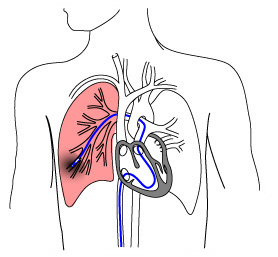Lung Cancer
Lung cancer is the leading cause of cancer mortality in the U.S. It is both a primary disease and a secondary, metastatic complication of other cancers. All cancers begin and progress as a vascular disease. Without new blood vessels feeding tumors, cancers would never get larger than a pinhead. Therefore, attacking the growth source of the tumor, the so-called neovasculature or “new blood vessels”, has become the new method of fighting cancer – a technique generally known as “anti-angiogenic therapy”.
Recent research has discovered that the innermost layer of cells that line blood vessels, endothelial cells, are not uniform throughout the body. Advanced proteomic techniques have been employed to illustrate the differences in endothelial cell proteins and receptors lining blood vessels in different organs, and between blood vessels lining normal tissues and cancerous tumors. 
Proteins have been discovered in lung endothelial cells that promote the metastasis and invasion of the lung by other tumors, such as breast cancer. Differences in endothelial cell proteins and receptors between ethnic groups have been noted, and differences that extend to the level of individuals have been proposed.
The endoarterial biopsy catheter will provide a tool to obtain samples of endothelial and subendothelial cells from blood vessels lining lung cancer tumors safely and effectively in a minimally invasive fashion.
Pulmonary endoarterial biopsy samples can also be obtained from cancer patients at risk for secondary lung cancer metastasis. Biopsy samples can be analyzed using sophisticated proteomic techniques in order to identify protein and receptors characteristic of metastasis.For example, several groups have discovered proteins in the pulmonary arteries that allow breast cancer to metastasize preferentially to the lungs.Use of our pulmonary endoarterial biopsy catheter could inform breast cancer patients if they have such proteins in their pulmonary arteries and their risk of metastasis.
Knowledge of a patient’s endothelial cell protein and receptor patterns could also be used to deliver individualized therapies by creating therapeutic agents to specifically target those receptors and proteins. The information would allow physicians to diagnose and stage disease, as well as customize therapy according to each patient’s potentially unique pattern of endothelial cell protein expression. Identifying protein and receptor signatures in endothelial cells lining blood vessels adjacent to tumors would provide oncologists with a powerful tool to diagnose and customize treatment for lung cancer and prevent lung metastasis from other cancers.
WARNING: Investigational Device. Limited by Federal law to investigational use. This device should be used only by physicians with a thorough understanding of percutaneous interventional procedures and training in the use of the endoarterial biopsy catheter.
DISCLAIMER: The material provided on this site is strictly for informational purposes. Do not use this site as a substitute for medical care or medical advice. Please consult with your physician or other medical care provider regarding any medical questions you may have.

